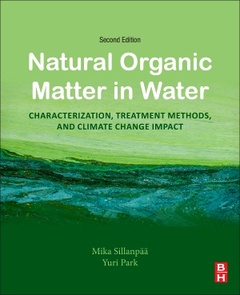Natural Organic Matter in Water (2nd Ed.) Characterization, Treatment Methods, and Climate change Impact
Auteurs : Sillanpaa Mika, Park Yuri

Natural Organic Matter in Water: Characterization, Treatment Methods, and Climate Change Impact, Second Edition focuses on advanced filtration and treatment options, as well as processes for reducing disinfection by-products, making it an essential resource on the latest breakthroughs in the characterization, treatment and removal of natural organic matter (NOM) from drinking water. Based on the editor?s years of research and field experience, the book covers general parameters, isolation and concentration, fractionation, composition and structural analysis, and biological testing, along with removal methods such as inorganic coagulants, polyelectrolytes and composite coagulants.
In addition, sections cover electrochemical and membranes removal methods such as electrocoagulation, electrochemical oxidation, microfiltration and ultrafiltration, nanofiltration, and membrane fouling. This book is a valuable guide for engineers and researchers looking to integrate methods, processes and technologies to achieve desired affects.
2. Impact of Climate change to NOM
3. NOM properties and characterization
4. NOM removal by Coagulation
5. NOM removal by Electrochemical methods
6. NOM removal by Membrane processes
7. NOM Removal by Advanced Oxidation Processes
8. NOM Removal by Adsorption
9. NOM Removal by Ion Exchange
10. NOM Removal by Biological treatment
11. Integrated Methods
12. Concluding Remarks
Mika Sillanpää’s research work centers on chemical treatment in environmental engineering and environmental monitoring and analysis. He received his M.Sc. (Eng.) and D.Sc. (Eng.) degrees from Aalto University, where he also completed an MBA degree in 2013. He has published more than 850 articles in peer-reviewed international journals. Dr. Sillanpää has received numerous awards for research and innovation. He is the first Laureate of Scientific Committee on the Problems of the Environment (SCOPE)’s Young Investigator Award, which was delivered at the UNESCO Conference in Shanghai 2010 for his “significant contributions, outstanding achievements, and research leadership in Environmental Technological Innovations to address present water pollution problems worldwide, especially with regard to wastewater treatment and reuse. He has supervised over 60 PhDs and has reviewed over 250 academic journals and published more than 1000 articles in peer-reviewed international journals. He has served on the editorial boards of several scholarly publications.
Dr. Yuri Park completed her PhD degree at Queensland University of Technology, Australia in 2013 and obtained her Post-doctoral fellowship at Dalhousie University with Centre of Water Resources and Studies. Currently, she is appointed as an assistant professor in DGC, at LUT University and throughout her academic and research career. Her main research areas are the synthesis of sustainable nanomaterials and their application for environmental remediation, water quality analysis, and development of water treatment techniques such adsorption, extraction and AOPs including UV, Ozone, and photo(electro)catalysis, analytical method development/validation, and chemical analysis of environmental contaminants in various matrices,. She has published more than 25 articles in the past six years in international journals in the fields of chemistry, material science, earth and planetary science, and environmental science and e
- Provides a summary of up-to-date information surrounding NOM
- Presents enhanced knowledge on treatment strategies for the removal of NOM
- Covers conventional as well as advanced NOM removal methods
Date de parution : 10-2022
Ouvrage de 376 p.
15.2x22.8 cm
Thèmes de Natural Organic Matter in Water :
Mots-clés :
Adsorbing materials; Adsorption; Advanced oxidation processes (AOP)s; Anthracite; Biofilter; Biofiltration; Brownification; Characterization; Chromatography; Climate change; Coagulation; Coupling; Drinking water treatment; Drinking water; Electrochemical methods; Electrocoagulation; Electrooxidation; Fenton; Filtration; Fouling; Fractionation; FTICR-MS; Granular activated carbon (GAC)Natural organic matter (NOM)Integrated processes; Ion exchange; Membrane technology; Microfiltration; Nanofiltration; Natural organic matter (NOM)NMR; Natural organic matter (NOM)Oxidation; Natural organic matter (NOM)Ozone; Natural organic matter (NOM)Recovery from acidification; Natural organic matter (NOM)Reverse osmosis; Natural organic matter (NOM)Water analysis; Natural organic matter (NOM)Water treatment; Natural organic matter; NOM; Photocatalysis; Process integration; Removal efficiency; Spectroscopy; Ultrafiltration; Ultrasound; UV light; Water treatment



